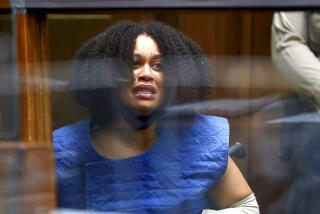Survivor Offers Sober Reminder
- Share via
The pictures in Michele Sapper’s photo album are stark and disquieting. Looking at them, you wince inside, silently.
You see the faces of her family crowded around her hospital bed as she lay comatose after a drunk driver plowed head-on into her car. You see the bandages and tubes to her broken body, her brain stilled by the horrible crash.
“I was killed on impact, brought back to life by CPR and in a coma for two months,” Sapper recalled of that night 16 years ago. “Then a new Michele was born.”
Defying doctors’ predictions, Sapper went on to finish college and today, as a reserve police officer, helps educate Los Angeles police officers about drunk drivers. Though she still struggles with the effects of the crash--her speech is slow and slurred, her walk is measured and cautious--Sapper, 37, silenced a room full of Los Angeles police officers, lawmakers and experts who gathered Monday for a San Fernando Valley traffic summit at the Airtel Hotel in Van Nuys.
LAPD officials said 61 people have died on Valley streets so far this year and, with the holidays approaching, the region is on track to reach last year’s total of 74 fatalities. Speeding is the usual culprit, and the Valley’s broad, often six-lane streets are frequently treated by drivers as makeshift freeways.
Traffic accidents cause more deaths and injuries in the Valley than all violent crimes combined, including homicides, said LAPD officials.
Los Angeles Police Department Deputy Chief Michael Bostic said everywhere he goes in the region, traffic is the top issue.
“This place is the wild, wild West,” Bostic, who heads the LAPD’s Valley Bureau, told the audience of about 300. “I’ve never seen people drive like they do here.”
While traffic motorcycle officers often write 15 to 20 tickets a day, officers in patrol cars may cite just one or two offenders a month, Bostic said. One goal is to make traffic enforcement a priority for all Valley police officers. “I want drivers in the Valley to be as afraid of black and whites [patrol cars] as they are motorcycle cops,” he said.
Traffic deaths strike a personal chord with Bostic, as well.
As a Lakewood teenager, Bostic escaped death when the car he was riding in was hit by a drunk driver, but his best friend, who was driving the car, died. Many years ago, Bostic’s brother was killed in a crosswalk by a motorist, and Bostic also lost a former LAPD partner who died in an accident while on patrol.
It doesn’t surprise Capt. Greg Meyer of the LAPD’s Valley Traffic Division to see people flying along some northern stretches of Balboa Boulevard at 80 mph. Nor is it a surprise when drivers get ticketed on Victory Boulevard for zipping by at 70 mph. Whether accidents occur at left turns, busy intersections, or crosswalks, they usually boil down to people in a hurry, Meyer said.
The toll is evident every day in hospital emergency rooms, said Dr. Ed Lowder, an ER doctor at Northridge Hospital Medical Center. The grim, and often grisly, task of trying to save battered and burned bodies seems to stem from human choices--speeding, deciding to drink and drive, a moment of distraction, he said.
“It’s made me a more defensive driver,” Lowder said. “When I leave the ER after a late night shift, I am very careful at intersections. I know there are a lot of people who have been drinking after midnight.”
Educating children, who are often vulnerable as pedestrians, and drivers both young and old, is one of the best ways to reduce traffic deaths, the LAPD said.
Officer Santiago Rosales often cautions school children about those new, sleek metal scooters that are all the rage.
At campus assemblies, where he teaches children to be car savvy, Rosales said he now wheels in one of the popular scooters to wide-eyed enthusiasm.
Stepping aboard the scooter, he said he pleads with children to be careful as they zoom down sidewalks and streets. With the holidays around the corner, parents who give the scooters as gifts, he said, must insist that helmets and protective arm and leg pads always be worn.
No protective gear could have helped Sapper the night of May 1, 1984.
A vivacious junior at Cal State Northridge, Sapper was on Plummer Street east of Zelzah Avenue returning to her dorm when a three-time drunk driver slammed into her Oldsmobile Cutlass. Although she was wearing a seat belt, Sapper’s pelvis was fractured and she suffered severe head injuries. Sapper says she “died” but was reborn, she explains, because of a doctor who lived just a few doors away from the accident administered cardiopulmonary resuscitation, keeping her alive.
After two months in a coma, she defied doctor’s predictions, and like a newborn, learned to walk and talk again.
Eventually she finished a communications degree at UCLA, and is an LAPD specialist reserve officer, educating the department about drivers who are under the influence. In other words, she said, “I get them really mad about drunken drivers.”
Sapper also speaks to young traffic offenders after they are ordered by the courts to take a tour of the Los Angeles coroner’s office.
“It’s the ol’ one-two punch,” she said of the morgue tour and her frank discussion with teen drivers. “I heard they have not had a repeat arrest since the program began.”
More to Read
Sign up for Essential California
The most important California stories and recommendations in your inbox every morning.
You may occasionally receive promotional content from the Los Angeles Times.













